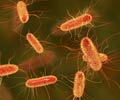Why is toilet hygiene important? Not washing your hands properly after going to the toilet can put you at a higher risk of catching potentially deadly E.coli infection than eating undercooked chicken, beef, or pork, reveals a new study.

TOP INSIGHT
Why is toilet hygiene important? Not washing your hands properly after going to the toilet can put you at a higher risk of catching potentially deadly E.coli infection than eating undercooked chicken, beef or pork.
Read More..
E. coli has become considerably more antibiotic resistant over the past 20 years both in humans and animals. Particularly important are strains with ’Extended Spectrum Beta-Lactamases (ESBLs). These are enzymes that destroy many important penicillin and cephalosporin antibiotics. Many strains with ESBLs often have other key resistances too.
But until now, it has not been known whether antibiotic-resistant E. coli that cause bloodstream infections are picked up via the food chain, or passed from person to person.
To answer this question, scientists sequenced the genomes of resistant E. coli from multiple sources across the UK - including from human bloodstream infections, human feces, human sewerage, animal slurry and meat including beef, pork and chicken, and fruit and salad.
Their report in The Lancet Infectious Diseases reveals that antibiotic-resistant ’superbug’ strains of E. coli from human blood, feces and sewerage samples were similar to one another. Strain ’ST131’ dominated among ESBL-E. coli from all these human sample types.
In short, there was little crossover of ESBL-E. coli from animals to humans.
"But E. coli is also the most common cause of blood poisoning, with over 40,000 cases each year in England alone. And around 10 percent of these cases are caused by highly resistant strains with ESBLs.
"Infections caused by ESBL-E. coli bacteria are difficult to treat. And they are becoming more common in both the community and hospitals. Mortality rates among people infected with these superbug strains are double those of people infected with strains that’re susceptible to treatment."
ESBL-E. coli are widespread in retail chicken meat and food animals too but, until now, the extent of transmission from these sources to humans has been uncertain, with the role of the food chain debated.
Prof Livermore said: "We wanted to find out how these superbugs are spread - and whether there is a cross-over from the food chain to humans."
The team compared ESBL-E. coli from infected human blood samples with those from human feces, sewage, food, dairy farm slurry and animals across five UK regions - London, East Anglia, Northwest England, Scotland and Wales.
The ESBL-E. coli infected blood samples came from NHS laboratories. Food studied included beef, pork, chicken, fruit and salad.
Prof Livermore said: "We looked at more than 20,000 fecal samples and around nine per cent were positive for ESBL-E. coli across the regions, except for in London, where the carriage rate was almost double - at 17 percent.
"We found ESBL-E. coli in 65 percent of retail chicken samples - ranging from just over 40 percent in Scotland to over 80 percent in Northwest England. But the strains of resistant E. coli, were almost entirely different from the types found in human feces, sewage and bloodstream infections.
"Only a very few beef and pork samples tested positive, and we didn’t detect ESBL-E. coli at all in 400 fruit and vegetable samples - many of which were imported to the UK.
"In short, what the results show is that there are human-adapted strains of ESBL-E. coli, principally ST131, which dwell in the gut and which occasionally - usually via UTIs - go on to cause serious infections. And that there are animal strains of ESBL-E. coli.
"But - and critically - there’s little crossover between strains from humans, chickens and cattle. The great majority of strains of ESBL-E. coli causing human infections aren’t coming from eating chicken, or anything else in the food chain. "Rather - and unpalatably - the likeliest route of transmission for ESBL-E. coli is directly from human to human, with fecal particles from one person reaching the mouth of another.
"We need to carry on cooking chicken well and never to alternately handle raw meat and salad. There are plenty of important food-poisoning bacteria, including other strains of E. coli, that do go down the food chain. But here - in the case of ESBL-E. coli - it’s much more important to wash your hands after going to the toilet.
"And it’s particularly important to have good hygiene in care homes, as the most of the severe E. coli infections occur among the elderly." Prof Neil Woodford of Public Health England said: "In order to tackle antibiotic resistance, we not only need to drive down inappropriate prescribing, but reduce infections in the first place. In order to limit serious, antibiotic resistant E. coli bloodstream infections, we must focus on thorough hand washing and good infection control, as well as the effective management of urinary tract infections.
"Prudent use of antibiotics is essential in both animals and humans. Antibiotics are a finite resource. We need them to continue to work when we get sick. "We are committed to reducing infections in both the community and in healthcare settings, and are working with front-line NHS staff, NHS England, NHS Improvement and the Department of Health and Social Care to do this."
Source-Eurekalert
 MEDINDIA
MEDINDIA




 Email
Email







